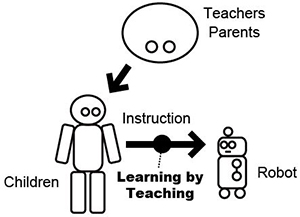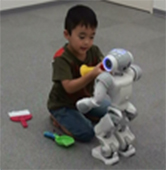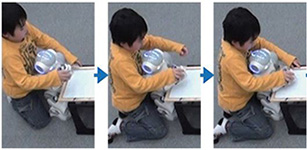In contrast to conventional teaching agents (including robots) that were designed to play the role of human teachers or caregivers, we propose the opposite scenario in which robots receive instruction or care from children. We hypothesize that by using this care-receiving robot, we may construct a new educational framework whose goal is to promote children’s spontaneous learning by teaching through their teaching the robot.

The original concept of the care-receiving robot (CRR) was proposed in 2009 by Dr. Fumihide Tanaka. We then tested the concept in various learning cases such as language learning and hand writing tasks, and confirmed that this robot helped children’s learning very effectively as hypothesized. Now this care-receiving robot application for child education is being commercialized (see this page).


- Fumihide Tanaka, Shizuko Matsuzoe: Children Teach a Care-Receiving Robot to Promote Their Learning: Field Experiments in a Classroom for Vocabulary Learning, Journal of Human-Robot Interaction, Vol.1(1), pp.78-95, 2012 [pdf, 280KB]
- Shizuko Matsuzoe, Fumihide Tanaka: How Smartly Should Robots Behave?: Comparative Investigation on the Learning Ability of a Care-Receiving Robot, Proceedings of the 21st IEEE International Symposium on Robot and Human Interactive Communication (RO-MAN 2012), pp.339-344, Paris, France, September 2012 [pdf, 1.7MB, IEEE Xplore]
- Fumihide Tanaka and Takeshi Kimura: The Use of Robots in Early Education: a Scenario based on Ethical Consideration, Proceedings of the 18th IEEE International Symposium on Robot and Human Interactive Communication (RO-MAN 2009), pp.558-560, Toyama, Japan, September 2009 [pdf, 263KB, IEEE Xplore]
(Updated on June 27, 2019)
